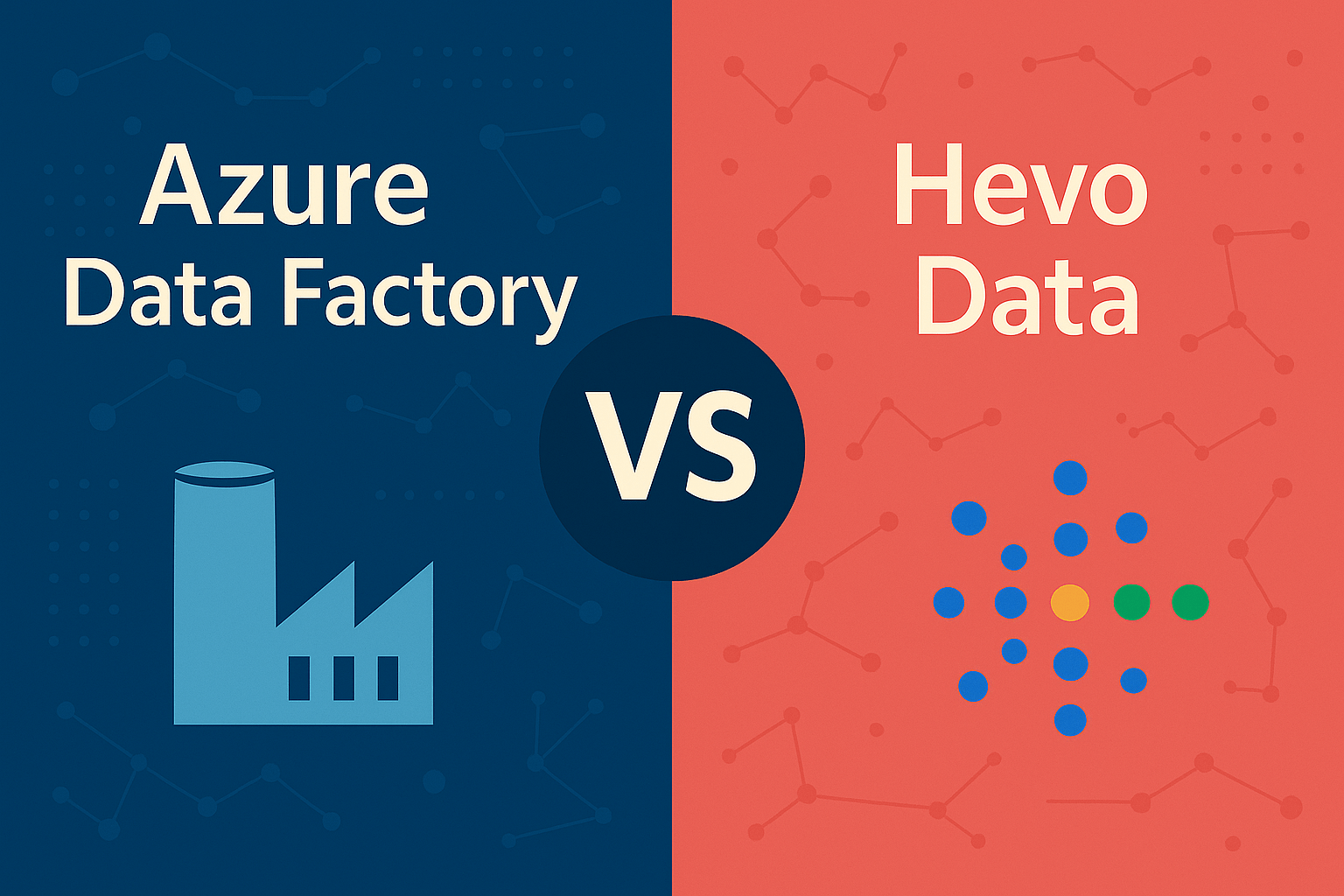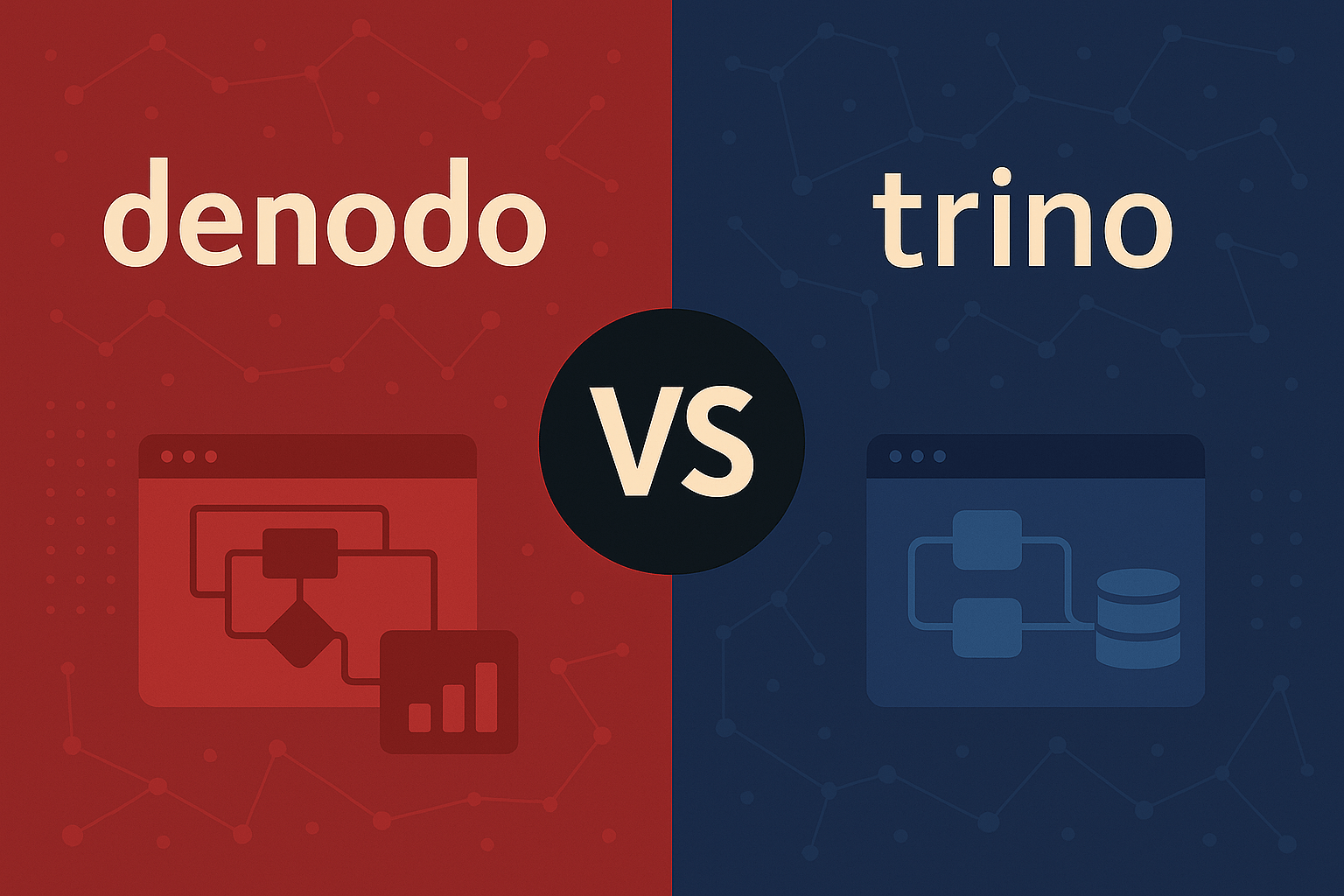Denodo vs AtScale: Which Data Platform is Right for Your Business?
Modern enterprises face an unprecedented challenge: accessing and analyzing data scattered across dozens of systems, from legacy databases to cloud platforms. Big data platforms are essential infrastructure for real-time data processing, storage, and analytics, and Denodo and AtScale are often compared in this context. Two leading data virtualization platforms have emerged to tackle this problem, but they take fundamentally different approaches. Denodo positions itself as a comprehensive data virtualization solution for enterprise-wide integration, while AtScale specializes in creating semantic layers that accelerate business intelligence workloads.
This comprehensive comparison will help you understand which platform aligns with your organization’s data architecture needs. Whether you’re looking to streamline data access across your entire enterprise or accelerate analytics performance for business users, the choice between these data virtualization tools can significantly impact your data strategy’s success.
Optimize Your Data Integration Success
Both Denodo and AtScale serve the critical function of data integration, but their methodologies differ substantially. Denodo focuses on enterprise data virtualization, creating a unified view of data from multiple sources without requiring data movement. This approach enables organizations to query data across relational databases, data lakes, cloud platforms, and legacy systems as if they were a single database.
AtScale takes a more specialized approach, concentrating on semantic layer creation and BI acceleration. Rather than attempting to virtualize all enterprise data, AtScale creates virtual OLAP cubes that sit on top of existing data warehouses and data lake platforms, optimizing analytical query performance for business intelligence tools.
The decision framework centers on a fundamental question: Do you need comprehensive enterprise data virtualization across diverse sources, or are you primarily focused on accelerating analytics performance for business users? Understanding this distinction is crucial for making the right platform choice. Selecting the right data virtualization approach can also lead to significant cost savings by reducing expenses related to data storage, infrastructure, and labor.
Your specific data architecture needs will determine which solution provides the most value. Organizations with complex, heterogeneous data environments often benefit from Denodo’s broad connectivity, while companies with established cloud data platforms seeking faster analytics insights may find AtScale’s specialized approach more effective.
What Makes These Data Platforms Unique?
Denodo – Enterprise Data Virtualization Excellence
Denodo operates as a leading data virtualization platform that creates a virtual layer between data consumers and disparate data sources. The platform connects to over 150 different data sources, including everything from mainframe systems to modern cloud platforms, and supports integration of both structured and unstructured data sources, without requiring data replication or movement.
The platform’s strength lies in its advanced metadata management and data governance capabilities. Organizations can implement robust access controls, data masking, and comprehensive data lineage tracking across all connected sources. This makes Denodo particularly valuable for enterprises dealing with regulatory compliance requirements or complex data governance needs.
Real-time federated queries represent another core capability. Business users can access data from multiple sources simultaneously, with Denodo’s query optimization engine ensuring acceptable performance even when dealing with complex data transformations. The platform’s caching mechanisms further enhance performance for frequently accessed data.
Denodo supports hybrid cloud, on-premises, and edge deployments, making it suitable for organizations with diverse infrastructure requirements. The platform’s enterprise-grade security features include role-based access controls, data masking, and integration with existing identity management systems.

AtScale – Semantic Layer and BI Acceleration
AtScale specializes in creating virtual OLAP cubes on top of existing data warehouses and data lake platforms. Rather than moving data, AtScale creates a semantic layer that enables business users to interact with complex data using familiar business terminology and concepts.
The platform’s live querying architecture ensures that analytical queries always access the most current data available in the underlying data platforms. AtScale delivers efficient query execution by leveraging advanced query optimization and push-down execution techniques, enabling faster insights and improved performance for complex analytics workloads. AtScale’s adaptive caching system, known as “Reflections,” automatically identifies frequently accessed data patterns and creates optimized data structures to accelerate repeated analytical queries.
AtScale provides both MDX and SQL interfaces, supporting integration with multiple BI tools including Tableau, Power BI, Excel, and other analytics platforms. This versatility ensures that existing business intelligence investments continue to provide value while gaining significant performance improvements.
Consistent semantic modeling represents a key differentiator. Organizations can define business metrics, calculations, and hierarchies once within AtScale, then expose these unified KPIs across all connected BI tools. This approach eliminates inconsistencies that often arise when different teams create their own data interpretations. AtScale provides consistent KPIs for supply chain and operational analytics, ensuring that all stakeholders work with the same reliable data.
Denodo vs AtScale: Head-to-Head Comparison
Primary Use Case
Denodo excels in enterprise data integration scenarios where organizations need to unify access across diverse data sources. The platform handles real-time operational queries, supports transactional data access, and provides comprehensive data governance capabilities. Denodo prioritizes enterprise data integration, while Dremio focuses on accelerating lakehouse analytics with minimal ETL. Organizations typically choose Denodo when they need to create a unified view of business data across multiple departments and systems.
AtScale focuses specifically on BI and analytics acceleration for organizations that already have established data warehouses or data lakes. The platform creates semantic layers that make complex data accessible to business users while dramatically improving query performance for analytical workloads.
Query Performance
Denodo employs query federation with intelligent caching to optimize performance across diverse data types and sources. The platform’s query optimizer analyzes incoming requests and determines the most efficient execution path, whether that involves accessing cached data, pushing queries down to source systems, or combining data from multiple sources. Denodo also supports real-time integration of data from multiple sources, enabling timely decision-making by providing live, seamless access to operational and analytical data.
AtScale leverages Apache Arrow in-memory processing and its proprietary “Reflections” caching technology specifically for analytics workloads. This specialized approach often delivers superior performance for OLAP-style queries and complex analytical calculations compared to general-purpose data virtualization solutions.
Target Users
Denodo primarily serves IT architects, data engineers, SQL developers, and enterprise data teams responsible for managing organization-wide data access. The platform requires technical expertise to configure and maintain, making it better suited for organizations with dedicated data management resources.
AtScale targets business analysts, BI developers, and data scientists focused on analytics use cases. The platform’s semantic layer approach makes complex data more accessible to non-technical users while still providing the flexibility that technical users require for advanced analytics. Manufacturers benefit from AtScale's ability to unify IoT sensor data with ERP metrics, enabling more comprehensive insights into operational performance.
Deployment Complexity
Denodo requires enterprise-scale setup and comprehensive governance configuration. Organizations typically need dedicated IT involvement to properly implement the platform’s full capabilities, including data source connections, security policies, and performance optimization.
AtScale offers a more streamlined deployment process specifically designed for analytics teams. The platform focuses on faster time-to-value for BI use cases, with simpler configuration requirements for organizations that primarily need analytics acceleration rather than comprehensive enterprise data integration.
|
Feature |
Denodo |
AtScale |
|---|---|---|
|
Primary Focus |
Enterprise data virtualization |
Semantic layer and BI acceleration |
|
Data Sources |
150+ connectors |
Major cloud data platforms |
|
Target Users |
IT architects, data engineers |
Business analysts, BI developers |
|
Deployment Time |
3-6 months |
4-8 weeks |
|
Market Share |
34.2% |
6.5% |
|
Best For |
Comprehensive data integration |
Analytics performance optimization |
Real-Time Data Access: Meeting Modern Business Demands
In today’s fast-paced business environment, real-time data access is no longer a luxury—it’s a necessity. Organizations must be able to respond instantly to market shifts, customer demands, and regulatory changes. Data virtualization is at the heart of this capability, providing a single virtual data layer that seamlessly integrates data from multiple sources, including data lakes, data warehouses, and cloud platforms. By eliminating the need for physical data replication or movement, data virtualization allows businesses to access data from multiple sources in real time, ensuring that decision-makers always have the most current information at their fingertips.
Leading data virtualization platforms, such as Denodo and TIBCO Data Virtualization, leverage advanced query optimization and data caching techniques to deliver fast, efficient data access. These capabilities streamline data access across the organization, enabling business intelligence teams to query data from multiple sources without delay. As a result, companies can gain valuable insights, make data-driven decisions, and maintain a competitive edge. By adopting a modern data management approach powered by data virtualization, organizations can unlock instant insights and drive better business outcomes.
Security Concerns with Data Virtualization
As organizations embrace data virtualization to integrate and access data from multiple sources, security becomes a paramount concern. Data virtualization solutions must ensure that sensitive data assets are protected at every stage of access and integration. To address these challenges, leading platforms incorporate robust access controls, encryption, and authentication mechanisms, ensuring that only authorized users can view or manipulate data from multiple sources. Additionally, data virtualization provides secure access to data for audits and reporting, ensuring compliance with regulations.
Features such as data masking and encryption are essential for safeguarding sensitive information, especially when data is accessed across diverse environments. Oracle Data Service Integrator, for example, provides advanced security capabilities, including role-based access control and comprehensive data encryption, to secure the integration of data from multiple sources. By implementing these robust security measures, organizations can confidently leverage data virtualization solutions, knowing their data assets are protected and regulatory requirements are met.
What Data Professionals Say
Denodo users consistently praise the platform’s comprehensive data governance features and extensive connectivity options. Data architects appreciate the ability to connect legacy mainframe systems with modern cloud platforms through a single interface, while compliance teams value the robust data masking and access control capabilities that help meet regulatory requirements. Users also highlight that Denodo delivers trusted data for analytics and decision-making, ensuring access to accurate and reliable information without unnecessary delays.
Enterprise data teams highlight Denodo’s ability to handle complex data transformation requirements without requiring data movement. The platform’s metadata management capabilities receive particular recognition for enabling data cataloging and lineage tracking across diverse enterprise systems.
AtScale users frequently emphasize the platform’s analytics performance improvements and semantic layer simplicity. Business analysts report significant reductions in query response times, with some organizations seeing 10x to 100x performance improvements for complex analytical queries compared to direct database access.
BI developers appreciate AtScale’s consistent semantic modeling capabilities, which eliminate the need to recreate business logic across multiple BI tools. Data scientists value the platform’s ability to provide self-service analytics capabilities while maintaining data governance and security standards.

Implementation Requirements Overview
Denodo requires enterprise infrastructure capable of supporting comprehensive data virtualization across multiple sources. The platform offers an extensive library of connectors, enabling integration with a wide range of data sources and protocols. Organizations need dedicated IT resources for initial setup, ongoing maintenance, and optimization. The platform benefits from a comprehensive data catalog setup that documents all connected sources and their relationships.
Successful Denodo implementations typically require 3-6 months for full enterprise deployment, including data source integration, security configuration, and user training. Organizations should plan for substantial initial investment in platform configuration and ongoing resources for maintenance and optimization.
AtScale implementations focus on existing cloud data warehouses or data lake platforms as the foundation. The platform requires integration with existing BI tools and training for analytics teams on semantic layer concepts and best practices.
AtScale deployments typically complete within 4-8 weeks for analytics acceleration use cases. The streamlined focus on BI workloads reduces complexity compared to comprehensive enterprise data virtualization projects, enabling faster time-to-value for analytics teams.
Both platforms require thorough understanding of source data structure and security requirements. Organizations must invest time in data modeling, whether for Denodo’s comprehensive virtualization or AtScale’s semantic layer creation. Security planning is crucial for both platforms, though the scope differs based on each platform’s intended use cases.
Best Practices for Implementing Data Virtualization
Successfully implementing data virtualization requires a strategic approach that balances business needs with technical capabilities. Start by defining clear business requirements and identifying all relevant data sources to ensure the solution aligns with organizational goals. Designing a scalable and flexible data virtualization architecture is crucial for accommodating future growth and integrating new data sources as they emerge.
Robust governance capabilities are essential for maintaining data quality, managing metadata, and enforcing security across the virtualized environment. Leveraging advanced data virtualization tools, such as IBM Cloud Pak, can further streamline data access and management. These platforms offer features like data transformation, data caching, and query optimization, which enable faster data access and improved business intelligence.
By following these best practices—clear planning, comprehensive governance, and the use of advanced tools—organizations can ensure their data virtualization implementation delivers faster data access, enhanced data management, and reliable business intelligence, all while maintaining strong governance capabilities.
Which Data Platform is Right for You?
Choose Denodo if you need:
Enterprise-wide data virtualization across diverse legacy and modern systems represents Denodo’s primary strength. Organizations with complex data landscapes spanning mainframes, ERP systems, cloud platforms, and data lakes benefit from Denodo’s comprehensive connectivity and integration capabilities.
Real-time operational queries and transactional data access make Denodo essential for organizations that need to support both analytical and operational use cases. The platform’s ability to handle diverse data sources simultaneously enables unified views that support both business intelligence and operational decision-making.
Comprehensive data governance and regulatory compliance capabilities position Denodo as the preferred choice for heavily regulated industries. The platform’s data masking, lineage tracking, and access control features help organizations meet complex compliance requirements while maintaining data accessibility for authorized users.
Support for 150+ connectors including mainframes, ERP systems, and IoT platforms makes Denodo ideal for enterprises with diverse technology stacks. Organizations that have invested heavily in various enterprise systems can leverage Denodo to create unified data access without replacing existing infrastructure.
Complex data transformation and federation requirements favor Denodo’s comprehensive approach. Organizations that need to combine, transform, and analyze data from multiple sources benefit from the platform’s advanced query optimization and federation capabilities.
Choose AtScale if you need:
BI and analytics acceleration on existing data warehouses or cloud data platforms represents AtScale’s core value proposition. Organizations with established modern data platforms seeking to improve analytical query performance will find AtScale’s specialized approach highly effective.
Semantic layer creation to provide consistent business definitions across data sources addresses a common challenge in enterprise analytics. Organizations struggling with inconsistent metrics and calculations across different BI tools benefit significantly from AtScale’s unified semantic modeling approach.
Fast query performance for analytical workloads and dashboards makes AtScale attractive for organizations where analytical response time directly impacts business decisions. The platform’s specialized optimization for OLAP-style queries often delivers superior performance compared to general-purpose solutions. AtScale excels at scaling analytics on massive data sets, making it a preferred choice for organizations dealing with large-scale data environments.
Self-service analytics capabilities for business users enable organizations to democratize data access while maintaining governance standards. AtScale’s semantic layer approach makes complex data accessible to non-technical users without compromising data security or consistency.
Quick deployment focused on analytics use cases rather than full enterprise integration suits organizations that need rapid time-to-value for BI improvements. AtScale’s streamlined approach enables faster implementation for teams focused specifically on analytics acceleration.

Future of Data Virtualization
The future of data virtualization is bright, driven by the growing need for real-time data access, advanced analytics, and robust data governance. As data volumes surge and organizations increasingly rely on cloud platforms, data lakes, and relational databases, the demand for efficient data integration from multiple sources will only intensify. Data virtualization will continue to play a pivotal role by enabling businesses to access and analyze data in real time, without the overhead of physical data replication or movement.
Emerging technologies such as artificial intelligence (AI) and machine learning (ML) are set to further transform data virtualization. These innovations will automate data integration processes, enhance data quality, and provide deeper insights into data assets, empowering organizations to make more informed, data-driven decisions. As data virtualization solutions evolve, they will become an indispensable part of modern data management strategies, helping businesses improve outcomes, ensure compliance, and maintain a competitive advantage in an increasingly data-driven world.
Final Decision Framework
For comprehensive enterprise data integration spanning diverse sources and supporting both operational and analytical use cases, Denodo provides the breadth and depth required for complex enterprise environments. Organizations with extensive legacy systems, regulatory compliance requirements, or needs for real-time operational data access will find Denodo’s comprehensive approach essential.
For analytics acceleration and semantic layer creation on existing modern data platforms, AtScale offers specialized capabilities that can dramatically improve BI performance and user experience. Organizations with established cloud data warehouses or data lakes seeking to optimize analytical workloads will benefit from AtScale’s focused approach.
Consider your primary use case as the deciding factor: operational data access across diverse enterprise systems favors Denodo, while analytical insights from established data platforms favor AtScale. The distinction between comprehensive enterprise data virtualization and specialized analytics acceleration should guide your platform selection.
Evaluate your timeline and resource requirements carefully. Enterprise transformation projects requiring comprehensive data integration typically benefit from Denodo’s extensive capabilities, while organizations seeking quick analytics wins may find AtScale’s streamlined approach more suitable for their immediate needs.
Some organizations successfully use both platforms together for different use cases, leveraging Denodo for enterprise data integration and operational queries while using AtScale to optimize specific analytical workloads. This hybrid approach can provide the best of both worlds for large enterprises with diverse data requirements.
The choice between Denodo vs AtScale ultimately depends on whether your organization prioritizes comprehensive data virtualization across all enterprise systems or specialized analytics acceleration for business intelligence workloads. Understanding this fundamental distinction will guide you toward the platform that best serves your data integration and analytics objectives.
Factory Thread – Real-Time Process Integration Beyond Virtualization or Semantic Layers
Denodo unifies enterprise data access through broad virtualization. AtScale accelerates analytics with semantic modeling. Factory Thread takes a third path—real-time process orchestration tailored for operations teams working across complex system landscapes.
Instead of modeling data after it’s landed in a warehouse or virtually federating it at query time, Factory Thread integrates systems at the moment events happen—on the edge, in the plant, or in the control room.
Key differentiators:
-
Event-first orchestration – Trigger workflows from machine states, human input, or real-time metrics
-
No-copy system connectivity – Link ERP, MES, historians, and IoT platforms with live read-only access
-
Lightweight edge deployment – Operates inside secure networks without relying on cloud movement
-
No-code rules engine – Apply business logic, thresholds, or conditions in plain language
-
Purpose-built for OT+IT bridging – Designed for engineers, not just analysts or architects
Factory Thread isn’t a semantic layer or a virtualized query tool—it’s a modern workflow engine for automating decisions where they matter most: inside your operations. Ideal for teams needing live process triggers, compliance-by-design, and fast results—without the data modeling tax.
Share this
You May Also Like
These Related Stories

Azure Data Factory vs Hevo Data: Which Data Integration Platform is Right for You?

Denodo vs Azure Data Factory: Which Data Integration Solution is Right for You?



No Comments Yet
Let us know what you think